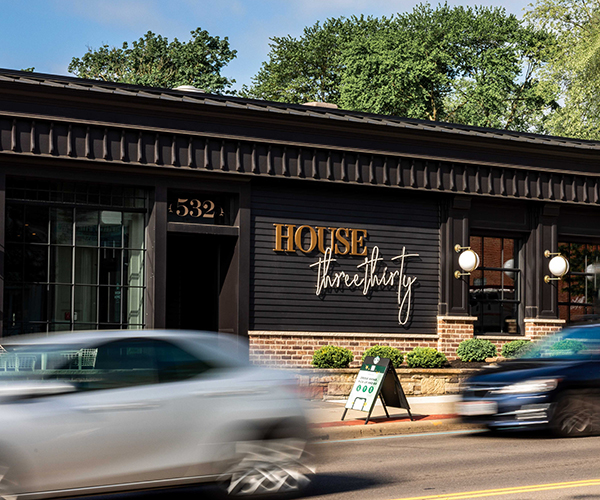Long-haired, leather-clad roadies stop tuning their guitars to watch the spectacle before them: 73-year-old Plain Dealer rock reporter Jane Scott is wearing green-and-black plaid gauchos, a matching scarf and a faux fur jacket over a black cardigan over a powder-blue silk blouse, the binoculars around her neck are there to enhance what her trifocals can’t make out, and she’s carrying two tote bags, a purse and reporter’s notebook.
Where’d you get your name? Would you call your sound heavy metal with melodic overtones^ Where’d the saxophone sound come from? Was that a piano or organ sample? What were you throwing into the crowd? Stickers? What kind of stickers? Just sticker stickers...
Pausing only long enough to hear the answers, Scott’s rapid-fire questioning seems disarming. But she’s writing furiously — eye contact never wavering — and tonight employs a demure smile, girlish giggle and a request for an autograph to keep the proceedings casual and her subject comfortable (other nights she may read palms or analyze handwriting to break the ice). None of tonight’s information appears in the next morning’s concert review, but some does show up under the “backstage†heading in her Friday! magazine “What’s Happening†column.
After 28 years of working the PD rock beat, Jane Scott has learned that over-reporting has its rewards. Someday, Supreme Love Gods may play the Stadium and deny press inter- views. But she’ll have insider information. And maybe they’ll remember Scott and her efforts. The Boss did. “His name is Bruce Springsteen,†Scott wrote in a 1975 concert review. “He will be a superstar.â€
The lead was out of character for the painstakingly objective reporter. “Boy did they want to take that out,†she says of her editors. “But I’m glad I fought for it.â€
Last August, Belkin Productions held a press conference at the Coliseum during Springsteen’s sound check. Among the doting Cleveland media, Springsteen spotted Scott wearing her collector’s item tour T-shirt, that signature scarf and a floppy hat.
“Jane!†the rock star nearly squealed as he jumped off the stage to give her a hug. Was he planning to play her favorite song, she asked, cradled under his arm?
“Maybe,†he replied with a grin.
Later that night, Springsteen yelled “Alright Jane†and, to the screaming delight of his fans, launched into his number-one hit “Dancing in the Dark.†The Springsteen story is one of hundreds, but Scott repeatedly dismisses her near-legend status. “People just react to a familiar face,†she says. AS FRIEND and PD colleague Mary Strassmeyer once told her, “The world doesn’t have characters anymore. Jane, you’re a character.†For people who’ve watched her work or met her only briefly, Jane Scott “the character†means the blond bob that hasn’t changed much since 1960 ... or the flair for fashion that means finding the perfect scarf ... or the presence once described this way — “she looks like someone who just got off the bus in the wrong town.â€
‘Jane gets the joke about herself,†says Michael Heaton, the PD’s “minister of culture.†Heaton grew up reading Scott’s columns and says they shaped his generation’s interest in and knowledge of rock ‘n’ roll. “The standard take on Jane is that nobody’s home. But forget the kooky image and all that world’s oldest teenager bull- shit. She’s sharp as a tack — and the hardest working reporter I’ve ever met. The woman will not be denied.â€
Everyone from local disc jockeys to national artists has a ‘Jane story,†and Heaton’s takes place in the corridors of the Coliseum after a concert. The reporter’s arms are flailing as she tries to convince a hulking security guard to let her backstage. “She’s arguing, he’s shaking his head,†Heaton says.
“Finally she shoves him out of the way — shoves him — and marches through the doors. The man was stunned. What in the world could he do? He’s not going to manhandle this 60-year-old woman.â€
Scott’s friends — and there are many — see past the amusing irony of her age and profession and note her relentless enthusiasm. “There’s some- thing interesting in every concert,†Scott tells you, “no matter if it’s not my style.†(Ice-T’s “Cop Killer†album, for example, is not Jane Scott’s style.) “There’s something incongruous about her age,†says 20-year friend Paula Slimak, a former PD features writer. “I remember being in a parking lot with her once, and she was talking to two little old ladies with blue hair and tight curls. When she was done, she turned to me and said, ‘I went to school with them.’ That was the first time that I ever realized she wasn’t of my generation.â€
In a music industry full of substance abuse, misogyny and superficial values, Scott’s optimism keeps her young. “You’d never know it from reading her,†says Virginia Stocking, Scott’s roommate in the early ‘40s, “but she’s terribly conservative.†Friends marvel at how she rarely criticizes or judges — in print or in private — the cultural milieu in which she exists eight hours a day. “I remember one concert where we smelled marijuana in the air,†Stocking says. ‘Jane didn’t pass judgement, she just reported the facts. She reported the aroma.â€
IF CLEVELAND and rock ‘n’ roll are an unbreakable chain, then Jane Scott is one of its strongest links. Longstanding members of the Cleveland music community, such as SCENE magazine editor Mark Holan, believe she’s worthy of induction into the Rock and Roll Hall of Fame. Not because she’s been around so long, but because Scott made one tangible contribution to the music industry. She invented a profession: rock critic.
Not only was she reviewing rock ‘n’ roll at a time when PD editors (and their national counterparts) considered it a cultural oddity, but she gave it the attention and scrutiny it deserved. In 1991, her peers inducted her into the Cleveland Press Club Hall of Fame. “Because of her,†read the pro- gram, “the press and the public came to take rock music seriously — both as an art form and as an industry.â€
But the stars aren’t the sole recipients of Scott’s attention. All the while, she has relentlessly advocated the local music scene. Beaucoup, the now defunct but once popular Cleveland pop-rock band, even wrote a song in her honor — “Jane.â€
“She’s always managed to persuade the PD to do an endless stream of stories on local bands,†says Anastasia Pantsios, a free-lance photographer, journalist and former PD columnist, “whether they were critically acclaimed — by some sort of local hip critics circle — or your average blues band.†With a job description that includes at least two concerts a week (about 120 a year, she says) and compiling details for her weekly “What’s Happening†column in Friday!, Scott often clocks more than her official 40-hour work week. At 73, she
Scott’s tenacity comes not from the see-and-be-seen motivations of the stereotypical rock reporter, but from an inherent curiosity that makes her, in Heaton’s words, “a managing editor’s ideal reporter.â€
One local musician remembers sitting through a half-hour telephone interview for a two-sentence write-up in Scott’s column. Another recalls delivering a photograph to the PD newsroom at 3 a.m. one winter Tuesday morning and finding Scott at her computer.
“I’ve adapted to my beat,†Scott says, laughing at her odd hours. “Ever try to talk to a working musician at 9 o’clock in the morning?â€
Scott began preparing for her dream job even before she graduated from Lakewood High School. She tilled out the first of four Plain Dealer applications and was flatly rejected. In 1941 she earned a bachelor’s degree in English from the University of Michigan, then enrolled in business college, “because I knew how to write, but not how to type and take short- hand.â€
“She worked at the Cleveland library for a brief time,†remembers Scott’s younger brother, Will. “She always was a voracious reader, but I think the whole idea of whispering all the time was alien to her. She naturally gravitated toward something people- oriented.â€
After five years as a lieutenant in the Navy (she worked with classified communications during World War II), selling ads for The Cleveland Press and several odd jobs, Scott landed a job with the Chagrin Valley Herald. She worked as a Plain Dealer stringer for five years before joining the paper full- time in March 1952 as an assistant society writer. “At the time, it was my only option as a woman,†she says.
Scott wrote about weddings and vacations until her big break: “I found two identical twins who were marrying two other identical twins. [The story] went over the AP wire and traveled as far as Pakistan. Finally, I had credibility.†In 1954, she was given the “pimples to pensions†beat of covering the seniors’ section and teen page.
Her life changed on August 14th, 1966 — the Beatles’ Cleveland press conference. She covered the event in her “Young Ohio†page and got such overwhelming response from pleased readers (which made for pleased editors) that she was allowed to “gradually†change the column’s focus to rock.
In 1987, the unthinkable happened. Jane Scott’s employers told the veteran reporter they were interviewing other rock ‘n’ roll writers and planned to phase her off the rock beat. Maybe, they told her, she could write about gardening.
“I see their point of view,†Scott says today of the event that broke her heart yesterday. “I was 68 years old. Except I wanted to be there, on the rock beat, in some way. So I wrote a letter saying I thought I had something to offer it with all my experience. It was such a big beat, I told them I felt I could still help out. I guess Thorn Greer [her managing editor at the time] thought I was right.â€
Scott may remember it that way, but others recall a media blitz. First, 126 PD employees signed a petition to keep her on the rock beat. Then, on March 24th, 1987, The Wall Street Journal hit the streets with a front-page profile. That was followed by a spread in People magazine and appearances on MTV, Entertainment Tonight, the Sunday Today show, Australian TV, an interview with Art Linkletter and a spot on Cleveland’s PM Magazine (one of its few nationally syndicated episodes). The Plain Dealer — looking every bit like a bully — backed off.
“Her goodness worked for her,†says Scott’s 25-year- friend Grace Kudukis, president of Woodruff, Inc., and an active member of the local benefit circuit. Kudukis remembers once urging Scott to write a “backstage†item about a popular Cleveland musician whom the two of them had seen taking off his wedding ring before a big concert. Scott refused to run the item; it was gratuitous trouble-making. “I didn’t see her reasoning; it was an interesting, colorful bit of gossip. But as it turned out, years later, when The Plain Dealer was trying to oust her, that very musician galvanized the support fin her. Of course, he had no idea about the story she never wrote.â€
I’M A BIT OF a pack rat I’m afraid,†Scott tells guests arriving at her Lakewood condominium for morning tea. “I don’t mean to be, but it’s so terribly hard to throw things out.â€
Scott lives modestly when you consider her comfortable “triple dipper†income (a salary, pension and Social Security benefits). “I keep careful records and make sure all my taxes are paid correctly,†she says through a mouthful of shortbread while tapping her foot to Neil Young’s new CD. Scott bought her tidy, two-bedroom condo in 1976. Decor is eclectic, a homey mixture of family photographs, Cleveland memorabilia and, well, stuff. The bedroom has two coat racks — one drooping under the weight of her tote bag collection, the other a willow of silk scarves.
In the living room are piles of news- papers (some 100 years old — she collects them), magazines {Vogue, HG and New York) and books. A stuffed cat (“my only petâ€) sits on her window sill. And a functional antique telephone made in 1910 by the North Electric Company of Cleveland hangs on her kitchen wall, where drawers are stuffed with recipes left unused and yellowed V1P passes to clubs long closed (the Rare Cherry, Roxy theatre and Viking Saloon).
But Scott’s vivid surroundings conceal the things the reporter in her doesn’t easily discuss. Like religion:
“Few people know this about her, but she’s very religious,†Grace Kudukis says of Scott’s membership in the Church of Christ, Scientist. “She doesn’t go to hospitals, and she doesn’t smoke, take aspirin or drink alcohol or coffee.â€
Politics: “Reporters shouldn’t discuss their politics,†Scott says. “I couldn’t stand Bush.†She admits to being a C-SPAN addict and says she comes from a long line of conservative Republicans. “But I’m the kind of Republican that votes for Glenn and Metzenbaum. I vote for the person.†And she’s pro-choice — “I don’t call it liberal, I call it sensible.â€
Retirement: “What would I do?†she asks dismissively. “I could shop, but that’s hard to do without a pay check.â€
“Jane’s life is incredibly full; she’s invited every- where,†says Kudukis, Scott’s frequent companion to the ballet, opera or theater ... flea markets, craft fairs or antique shows. Scott loves to travel and devotes consider- able time to several journal- ism organizations and civic groups. She also belongs to the Western Reserve Post Card Society and Society of Collectors at Dunham Tavern Museum.
Although Scott never had children, “she’s more than made up for it in her aunt role to my five children and 13 grandchildren,†says her youngest brother. “A party isn’t a party without Aunt Janey there, and all my friends consider Jane a close friend. She treasures that because she never had a family of her own.â€
“I hung out with somebody at the PD a long time ago,†she says quietly. “But then he left and later died. It wasn’t serious, more friendship than anything else.
“And I was engaged once, but I lost him to the war.â€
Which war? Jane Scott giggles. ‘The Civil.â€



